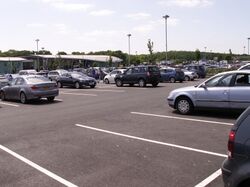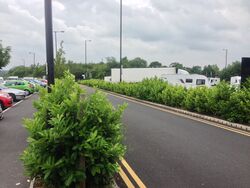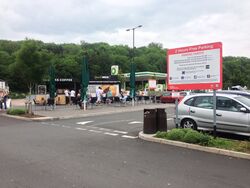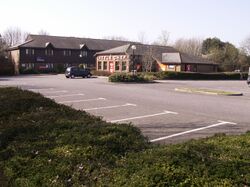Parking

It is a pretty obvious concept that service areas - which are built to serve motorists - should provide parking. Specifically, parking for all vehicles must be provided free for at least two hours, with more detail given below.
A significant portion of formal complaints regarding motorway service areas relate to parking. How can something so simple go so wrong? There appears to be a mismatch between what customers expect and what they are offered.
This page exists to provide a general overview. For specific queries and complaints you should contact the operator, who are likely to ask anybody complaining about a penalty charge to follow the appeals procedure sent to them.
Legal Requirements
According to Circular 01/2022, all official motorway and trunk A-road service areas and truckstops - that is those with official road signs directing people to them - must provide at least two hours free parking for all road users who are entitled to use the road. In practice, Circular 01/2022 only applies to some English trunk roads - its relevance elsewhere is only implied.
This free short stay must be provided regardless of whether the driver intends to leave the car or not. They also state that:
- The charging regime must be clearly displayed within parking areas and the amenity buildings.
- Drivers must at all times be afforded the opportunity to pay the charge at the site before leaving
- Drivers must be able to pay without a mobile phone while on-site.
- Cash payments must be accepted.
- CCTV and security lighting must be provided at new service areas and truckstops.
The two hour free period has been enshrined in government policy since 1979, on the basis that a service area's primary function is to cater for the immediate needs of motorists and that two hours was considered sufficient. While motorway service areas can make handy places for car-sharing or meetings, this is not meant to be their priority.
There is no rule that charges must apply after two hours, but convention is that all operators charge after two or three hours (and four hours is common in Ireland). There is no rule preventing service areas from asking people to leave after two hours. Buying food or drinks or charging their car does not absolve the customer of the need to pay for parking.
Many people take issue with the charges being levied at night, when the car parks are usually empty and drivers are more likely to be tired. Government policy doesn't comment on what's fair or not; it merely outlines what is allowed.
Hotels and meeting rooms attached to service areas usually provide free parking as part of the booking, but registration plates must be provided upon arrival. Since 2008, hotels need to contribute their share of parking spaces at a service area; the 2022 regulations says it must be "separate parking".
Small Print
In practice, none of this really matters. The same policy also states that the existing "parking provision", possibly dating back over 40 years, can continue to apply until the service area experiences major construction work. This is key: highway authorities are notoriously bad at record keeping, many of them use this website for information; they are unlikely to be able to cite a 40-year old agreement, or even know whether one was ever signed.
Circular 01/2022 was written by the Department for Transport and puts the onus on the national highway authority (currently National Highways) to ensure it is being followed. If a service area (usually a small A-road one) is trying to claim that it didn't know, or doesn't need to, provide 2 hours free parking, then that is a direct affront on the highway authority who are supposed to be enforcing the policy. Some people are assuming that this miscommunication can get them out of an otherwise legally solid parking charge: that approach has not been tested in court, and you would be very unwise to try it without seeking professional legal advice because, as this section tries to imply, there are many layers to this.
The exceptions continue even for brand new (or newly-refurbished) service areas. The updated policy says that, if the operator puts forward a good argument that they can't or shouldn't meet the full policy, then exceptions can be made. An obvious example of this would be an older service area not making space for each class of vehicle, and instead expecting longer vehicles to share an area, or banning them completely. And an even bigger complication arose in 2025, when National Highways admitted that a non-compliant site may still receive signposts, if the developer makes a good case for it.
Note as well that the free parking rule merely states that two hours free parking must be available, it doesn't state that all parking spaces must be free. Sites can operate different parking regimes in different car parks. This even happens on motorways, usually where the petrol station is owned by a different company to the main car park.
A famous exception to the rules is Stansted, which is a full trunk road service area built on airport land, so it enforces a strict and detailed parking enforcement regime which treats everybody with suspicion.
Road Layouts

See also: Internal Signs
As part of the planning process, a safe and efficient circulatory system for vehicles and pedestrians must be established both along the main roads and within the parking areas. There is no preferred layout, but pedestrians should be kept away from traffic as much as possible, while maintaining good visibility at crossing points.
The general consensus is that car parks normally go nearest the main entrance, and HGV spaces go further away. While very unpopular with HGV drivers, this layout arises because cars tend to bring a high turnover of people, including children and pets, so it makes sense to give them the shortest journey that has the least potential for injury.
As service areas are private property, their road layouts can be unusual. This is not supposed to be the case. We have detailed the issues over at Internal Signs.
When not at a junction, people often comment on how short the exit from a service area can be. This falls under the responsibility of the highway authority; the newest regulations say that full-length slip roads should be provided. See Online Services.
Many service areas have been built at very busy roundabouts, many of which were put there by the Department of Transport during their 1980s cutbacks. There are now several sites that frequently find that traffic cannot leave quick enough, creating long queues in the car park. Unfortunately the control of traffic trying to join the roundabout is the responsibility of the highway authority and not the service area operator. See Offline Services.
Maintenance
Service area operators are responsible for maintaining all roads, footpaths and parking areas on their site, and should be contacted if there is a safety concern.
The exact point responsibility transfers is normally by the site limits, and can usually be identified by a slight change in the age of the tarmac, by a wooden fence running close to the road, by white dots painted in the middle of the road or by the start and end of motorway signs.
Tracing landowners can become extremely complicated at A-road service areas, where the land is often leased and/or divided between companies.
Provision

Separate parking should be provided for coaches, caravans, lorries and abnormal loads, with drive-through parking bays preferred, and additional disabled spaces. Hotel guests now need separate parking spaces again, but electric vehicle charging points do now count towards the total parking provision.
The minimum number of spaces that must be provided is calculated relative to the traffic on the road, though exceptions are now permitted on a case-by-case basis. Smaller percentages are used for A-roads; the figures are halved for motorway rest areas; and truckstops use bare minimums. Most developers will allocate an additional area of land which can later be built on to provide additional parking spaces, instead of the previous method of adding haphazard overflow parking areas.
Nationally there is a severe shortage of HGV parking spaces, especially along motorways. Dedicated lorry parks are permitted and starting to open. Only ones positioned away from the motorway network are allowed to double-up as an operating centre.
History
All motorway service areas were originally required to offer free parking, at all times, and to monitor their sites for vehicles which had been abandoned. Nobody had considered overnight parking because sleeping in vehicles was too uncomfortable, and leaving your vehicle was unnecessary. The parking areas were divided into "private vehicles" and "commercials", with the two vehicle types usually having different needs, and therefore being kept well apart.
In 1966, following reports of excessive overstays, service areas were allowed to install signs allowing parking for "a reasonable period of rest and refreshment only". This period was not specified or enforced, beyond telling people to leave.
The government wanted to introduce new income streams to motorway service areas, both to help the struggling operators, and to help themselves (as the original contracts gave the government a percentage of each service area's income). In January 1971, they suggested that vehicles should be allowed to park overnight, with the impact on capacity being managed by "imposing reasonable charges". Parked vehicles had to be removed in the morning, and operators had to make provisions for safety and security. Service areas weren't allowed to expand their parking areas purely to cater for overnight parking, because of legal issues involving the compulsory purchase order that motorway service areas were built with at the time.
"Safety and security" was mostly concerned with the risk of fire. A ban on using cooking appliances in service area car parks had been in place since 1966, following a number of incidents caused by carelessness, and there were concerns that some sites had been designed with fuel pipes running under the car park.
Initially, the amount of overnight parking was low, as car drivers were used to using hotels and lorry drivers were happy with their digs. However it soon became commonplace, especially after the launch of the sleeper cab. Following the Prior Report of 1979, the standard practice became to define "short stay" as two hours, and to charge for any longer. The standard overnight parking charge was £3.50 (which is worth around £15 in 2025), and the charge for failing to pay would usually be £13.50. Clamping vehicles that overstayed without paying soon became common (£56).
Leases were soon changed to remove income from the equation. Service areas would outsource their parking areas to private companies who would physically patrol them, looking for vehicles to clamp, and operating from a hut where they could sell tickets, answer queries and deal with any issues. At the time, Moto had a stated policy that they wouldn't charge sleeping drivers. Patrolling car parks became a profitable business, and even more so when the on-site patrol officers were replaced by automatic camera systems in around 2010. England banned wheel clamping in 2012, and by now all charges were sent to the registered keeper by post.
Another nadir was reached during this era where some hauliers began to blacklist some service areas that had become vehicle crime hotspots. Operators factored this into new site designs but had many old sites with issues. Following the 2021 fuel crisis, HGV driver welfare was put in the spotlight, and the government put a series of grants in place which encouraged operators to introduce enhanced security measures.
Enforcement and Parking Charges

Most service areas outsource the management of their car parks to a private parking enforcement company (usually Group Nexus or ParkingEye). Traditionally, this involved a dedicated employee walking around and ensuring everybody who needed to pay had done so. Now the management is carried out remotely, with number plate recognition cameras. This is where service stations receive most of their complaints.
The government's Valuation Office Agency have stated that at service stations, "the income generated by [parking] penalties is significant" (source). They suggest that most sites split the revenue 50/50 between themselves and the enforcement company.
The cameras record the number plate of everybody entering and leaving the site, and issue charges to anybody who exceeds the free limit and hasn't paid. The enforcement companies are notorious for their difficult appeals processes. Note that being within the site for two hours is not exactly the same as being parked for two hours. Where somebody has been stuck in traffic in the car park, the operator should cancel all charges. There have been reports of frequent customers being wrongly charged.
Large signs are placed at the entrance and exit to every service area explaining that charges apply, as well as around the car park and the building. Despite this, people regularly contact us to say they didn't see them. Broken down vehicles must speak to staff for advice.
Enforcement is also carried out against vehicles which park in the wrong place, although this is less common as it requires staff intervention. Issues with incorrectly parked vehicles should be reported to a member of staff on duty. The practice itself is nothing new, and penalty charges for staying too long have been in place since the early 1980s.
Both the penalty charges and the standard parking charges, especially when they have inflexible charging periods like "2-24 hours", can be a valuable income stream for a service area that offsets other operating costs. While the penalty charges have brought considerable negative publicity, the system of outsourcing the job to profit-hungry companies means that the operators don't need to worry about patrolling their car parks for issues like abandoned cars, which did used to be a problem.
Appealing A Parking Charge
Issues with the enforcement process used to be sent to the operator, and gestures of goodwill were once quite common. Due to the volume of enquiries received, they will now normally refuse to intervene and instead tell you to make a formal appeal with the parking company.
Making an appeal with a parking company can be a frustrating experience, as they are very black-and-white about how they enforce the rules. There used to be a well-circulated internet rumour that if you ignored the charge it would go away, but this has been proven to be untrue.
This website is not in a position to advise people looking to fight private parking charges, and you should seek professional help, or a dedicated advice service, if you need it.
As an example, since 2010, Moto's website has stated, "it is not our intention to charge drivers who marginally exceed the parking restrictions", implying that there ought to be some leniency. In 2021 they began a new policy of refusing to engage with any penalty charge complaints on the basis that GDPR supposedly forbids them, but despite that they were able to make an exception in September 2021 when one man's case was taken up by Kent Online. Other operators have generally refused to enter into any correspondence about the subject; their strategies vary over time, and sometimes they are more forgiving than others.
How To Pay
At motorway service areas three parking charges are normally applied: one for cars, and two for all other vehicle types, with the option of including a food voucher.
Information on the charges and how to pay is detailed in each parking area. Where available, we provide that information in our database, but we would always encourage you to direct your enquiry to the operator.
Charges are normally paid in the shop or restaurant, with the option to pay in cash. Many service areas encourage you to pay using an app or phone call, usually with the option of paying retrospectively.
At dedicated truckstops, parking spaces may sometimes be booked in advance.
Security
Service area operators are responsible for ensuring their parking areas, as with the rest of the site, are safe. Historically the backs of car parks, and especially the lorry parks, have been difficult areas at night.
Operators were encouraged to secure the HGV parking with fencing and CCTV in 2013; this was made mandatory from 2022. Secure fencing is more common at dedicated truckstops; full fencing remains very rare on the motorway.
Moto are now providing dedicated security staff at some of their lorry parks. Corley northbound is trialling a secured parking area at a Welcome Break, with more planned.
Small Services

The majority of the text above applies to motorway service areas.
Official service areas signposted from A-roads, especially the smaller ones, are expected to follow the same policies but can struggle to reach these standards, especially if they were built as a family-run site. There are also some A-road service areas which were signposted by the local authority without checking whether they would be following Circular 01/2022.
The most common problem is that while the petrol station might consider itself an official service area, an adjacent restaurant or hotel may not. This means that the restaurant will not appreciate non-customers using their car park, but motorists are not able to tell the difference. To avoid any doubt, if the motorist is looking for free parking or toilets, they should normally head towards the petrol station.
Many small service area can only handle a limited number of HGVs. Where no HGVs can be accommodated at all, this should be explained on the signs, and drivers of long vehicles should expect to be able to access the stop. At some sites, HGVs are welcomed at the fuel bays only.
Further Reading
- PePiPoo - motorist's justice group. First point of call if you want to fight a charge.
- Money Saving Expert - private parking tickets advice
- Moto - parking queries page